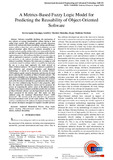| dc.contributor.author | Onyango, Kevin A. | |
| dc.contributor.author | Muketha, Geoffrey M. | |
| dc.contributor.author | Micheni, E. M. | |
| dc.date.accessioned | 2020-09-08T14:07:39Z | |
| dc.date.available | 2020-09-08T14:07:39Z | |
| dc.date.issued | 2020-08 | |
| dc.identifier.citation | International Journal of Engineering and Advanced Technology (IJEAT), Volume-9 Issue-6, August 2020 | en_US |
| dc.identifier.issn | 2249-8958 | |
| dc.identifier.uri | https://www.ijeat.org/wp-content/uploads/papers/v9i6/F1627089620.pdf | |
| dc.identifier.uri | http://hdl.handle.net/123456789/4437 | |
| dc.description | Retrieval Number: F1627089620/2020©BEIESP
DOI: 10.35940/ijeat.F1627.089620 | en_US |
| dc.description.abstract | Software reusability facilitates the engineering of new software or systems functionalities without having to start coding from scratch. This software quality provides numerous merits to the software developers including coming up with larger systems within a short time, with reduced development cost and reduced developer effort. However, software reusability is an external software quality attribute that is not measurable directly, and this is a major hindrance factor to its adoption in the software engineering process. This indicates that there is a need to come up with an approach to measure or predict software reusability to give advisories to the software developers on the prediction of software reusability. Therefore, this study aims at coming up with a prediction model to estimate software reusability by employing the use of a fuzzy logic approach, the study focused on
Object-Oriented software. The research followed a guideline of four objectives and assumed descriptive and diagnostic methodology. It started by considering the existing ISO/IEC 25010 software quality model to determine and describe the main factors affecting the reusability of Object-Oriented software. The] main factors identified were Abstraction, Cohesion and Coupling, thereafter, it was followed by the definition of metrics to measure each of the three factors identified, to operationalize these metrics, they were then validated using Weyuker’s nine properties. After this, the researchers developed a metrics tool to automate the process of computing the metrics values of the defined metrics. Finally, a fuzzy logic prediction model that predicts the reusability of Object-Oriented software was developed based on the metrics values computed by the metrics tool. This model was then validated using the Analytical Hierarchical Process (AHP) framework. The outcome of the four objectives was presented, discussed and future works of this study outlines. This research work is a contribution to the software development industry where the software developers can apply it to engineer reusable software. | en_US |
| dc.language.iso | en | en_US |
| dc.publisher | Blue Eyes Intelligence Engineering and Sciences Publication | en_US |
| dc.subject | Analytical Hierarchical Process | en_US |
| dc.subject | Fuzzy Logic | en_US |
| dc.subject | Metrics Tooling | en_US |
| dc.subject | Object-Oriented Software (OOS) | en_US |
| dc.subject | Software Metrics | en_US |
| dc.subject | Software Reusability | en_US |
| dc.title | A Metrics-Based Fuzzy Logic Model for Predicting the Reusability of Object-Oriented Software | en_US |
| dc.type | Article | en_US |

